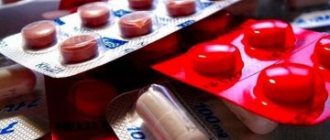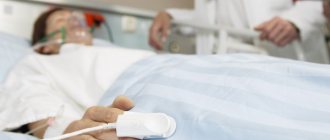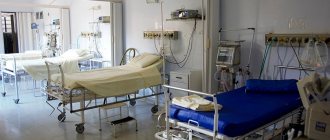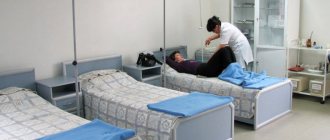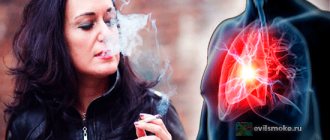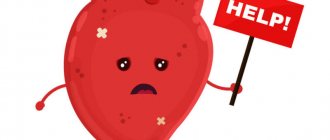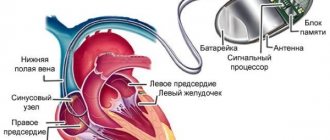Doctors' actions
Resuscitation for a heart attack involves intensive therapy aimed at maintaining basic vital functions and stabilizing the condition. To achieve results, certain prohibitions and recommendations are introduced. This:
- exclusion of physical activity;
- preventing the patient from contacting friends and relatives;
- strict adherence to bed rest;
- 24-hour monitoring by doctors;
- regular examination.
In case of cardiac arrest, cardiopulmonary resuscitation methods are used. You cannot spend time with them, so it is advisable that people nearby provide assistance (indirect cardiac massage and artificial respiration) to the patient. The arriving team of specialists will continue manipulations to preserve vital functions, preventing the death of brain cells. This condition occurs due to the cessation of cardiac function and respiratory function against the background of extensive necrotic lesions. The duration of resuscitation is usually approximately half an hour. The patient's chance of survival increases significantly when assistance is provided in the first five minutes after the attack.
The actions of doctors directly depend on the severity of the lesions, so the diagnosis is carried out:
- Magnetic resonance imaging;
- electrocardiography;
- cardiac catheterization;
- echocardiography;
- lab tests.
Based on its results, it will become clear what to do in intensive care during a heart attack. In most cases, the patient is prescribed intravenous medications to stabilize the heart, prevent the formation of blood clots and dilute them. In severe cases, surgery is recommended:
- stenting;
- coronary artery bypass grafting;
- excision of aneurysm;
- installation of an artificial pacemaker.
Diagnosis of the disease
Before treatment, the doctor conducts the following studies:
- MRI (magnetic resonance imaging). Thanks to this expensive examination, even the smallest areas of damage can be identified.
- An ECG (electrocardiogram) reveals signs of a heart attack; the procedure is quick and inexpensive.
- EchoCG (echocardiography) is a safe ultrasound procedure that reveals the location of the lesion, the condition of blood vessels and blood flow, and the presence of blood clots.
- Myocardial scintigraphy. Thanks to the injected contrast agent, the affected area is clearly visible on the image.
- Tests for biochemical markers. An increase in some indicators usually indicates a heart attack, but can also be caused by other reasons.
- Cardiac catheterization.
The subsequent treatment regimen depends on the diagnostic results and the severity of the heart attack.
How long do they stay in intensive care after a heart attack?
The duration of the course of therapy in a hospital setting depends on the patient’s condition, the speed of his recovery and the presence of complications. It can be divided into the following stages:
- The acute stage begins from the moment of the first manifestations of the attack and lasts for 2 weeks. The patient is hospitalized for resuscitation. Towards the end of this stage, he is transferred to the ward of the cardiology department.
- The subacute stage lasts approximately 3-4 weeks. The patient will have to stay in the hospital for this period to avoid complications and improve the condition.
No one will be kept in the clinic by force, but if you leave its walls on your own, doctors relieve themselves of all responsibility for the patient’s life. This is due to the high probability of developing thromboembolism and other consequences of a heart attack. If the patient gets better earlier than expected, then there is a chance of discharge in 2-3 weeks. Next comes the rehabilitation stage, during which the patient will have to follow the recommendations of specialists and be periodically examined. Typically, recovery takes no more than 1 year.
Sanatorium treatment after a heart attack
Restoring health in a sanatorium after a heart attack is not recommended for everyone. It depends on the severity class of the attack. It is determined according to the following classification:
- First class: absence of angina attacks and complications.
- Second class: heart failure of the 1st degree, minor complications.
- Third class: complications in the form of hypertension and arrhythmia. Heart failure above the second degree.
- Fourth class: serious condition, possible risk of sudden death.
Patients with the fourth severity class are not prescribed sanatorium treatment. It is advisable for the rest not to refuse this opportunity to restore their health. In sanatoriums, vacationers are offered moderate physical activity, hardening procedures, massages, and oxygen baths. A special diet and adherence to the regime play a significant role in restoring the body.
The rehabilitation program in the sanatorium is prescribed by the doctor based on an assessment of the patient’s condition. Not only the severity of the attack is taken into account, but also concomitant diseases and characteristics of the body.
After discharge
At home, a person who has survived a myocardial infarction will have to take medications every day designed to combat complications and reduce the load on the heart muscle. Tablets are commonly used to prevent blood clots (Aspirin) and to reduce myocardial oxygen demand (beta-adrenergic blockers) and cholesterol levels (statins). It is equally important to introduce certain restrictions:
- take breaks while working;
- adjust your diet;
- reduce physical activity;
- to refuse from bad habits;
- get enough sleep (7-8 hours a day).
The person will have to be examined periodically for a year after being discharged from the hospital. Based on the results obtained, the doctor will be able to monitor the speed of recovery.
How long do they stay in the intensive care unit?
The word “reanimation”, which frightens and alarms the average person, is translated as “revival”. This is where the real struggle for human life takes place.
In this department, the day is not divided into day and night: medical workers attend to patients every minute. The intensive care unit is a closed area of the hospital.
This is a forced measure that is necessary so that no one and nothing distracts doctors from saving human life. After all, some of the patients will never be able to leave the cold walls of the intensive care unit.
Relatives of such patients are worried because they do not know how long they have been in intensive care. How resuscitation treatment is carried out, what factors are associated with the length of a patient’s stay in the “rescue” department, you will learn from our article.
Specifics of the resuscitation state
Resuscitation is a department of a hospital where emergency actions are carried out to eliminate violations of the vital functions of the body. No one can answer how many days the patient will spend between life and death. Recovery time is always individual and depends on the type of injury, the patient’s condition and the presence of concomitant complications that appeared after the injury.
For example, after the operation, blood flow and spontaneous breathing were restored. However, at this stage a complication is diagnosed: cerebral edema or infection. Therefore, monitoring the patient’s condition in the intensive care unit will continue until all complications are eliminated. After this, the patient will be transferred to a regular ward.
It is important to understand that relatives, acquaintances and friends cannot visit the patient in the intensive care unit. This rule applies to all visitors with rare exceptions. Let's tell you why.
All visitors bring a lot of bacteria and viruses on their clothes, bodies and hands. They are absolutely safe for a healthy person. But for patients in serious condition, they will cause a complex infection. Moreover, patients themselves can infect visitors.
There are several patients in the general intensive care unit. Their location does not depend on gender: patients are undressed and connected to numerous equipment.
Not everyone will be able to calmly react to such an appearance of people close to them. Therefore, people who are worried about the condition of their relatives need to wait until the patients are transferred to therapy.
There it will be possible to communicate normally, regularly visiting friends and relatives.
Let us consider the features of resuscitation treatment in patients whose critical health condition is associated with the most common pathologies: stroke and heart attack.
Stroke
A stroke is a dangerous change in the blood circulation of the brain. He spares neither women nor men at any age.
Moreover, 80% of stroke cases are characterized by ischemic pathology and only 20% by the hemorrhagic type.
It is impossible to predict when the cerebral hemorrhage itself will occur: the course of the pathology is unique for each patient. Therefore, each patient spends a different time in intensive care after a stroke.
Victoria Rydos : People want a long and healthy life more than money. And I'm very happy about it. Therefore, it’s time to introduce you to a talisman that can really protect you from various ailments and allow you to live a long life. More details
How long a stroke will keep a person in the hospital depends on several factors:
- Localization and size of brain tissue damage;
- Severity of symptoms;
- Presence or absence of coma;
- Functioning of systems and organs: breathing, heartbeat, swallowing and others;
- Possibility of relapse;
- Presence of concomitant diseases.
As you can see, the patient will stay in the intensive care unit as long as his condition requires. Patients in the department are carefully examined every day, making a verdict on their further stay in the hospital.
It should be noted that in case of pathological changes in the brain, the patient is required to stay in intensive care for 3 weeks. This time is needed for the doctor so that he can track possible relapses and prevent them.
General standardization of stroke treatment involves a month. This period is approved by the Ministry of Health for the complete recovery of the patient. However, on an individual basis, the period of therapy is extended if it is determined that the patient needs further treatment and rehabilitation.
Stroke therapy includes 3 stages.
The first therapeutic course consists of basic treatment measures:
- Improve the functioning of the respiratory system;
- Adjust hemodynamics;
- Eliminate elevated body temperature and psychomotor disorders;
- Fight cerebral edema;
- Provide proper nutrition and care to the patient.
After restoration of the primary functions of the body, differentiated treatment follows. It depends on the type of stroke and the patient's condition.
Hemorrhagic stroke:
- Eliminate cerebral edema;
- Adjust intracranial and blood pressure indicators;
- Assess the need for surgical intervention.
Ischemic stroke:
- Restore good blood circulation in brain tissue;
- Improve metabolism;
- Eliminate manifestations of hypoxia.
The larger the affected area in the brain tissue, the more time the patient will need to recover.
Also, relatives should know what happens to the patient when he falls into a coma. This dangerous complication occurs only in 10% of cases.
A comatose state occurs due to instantaneous dissection of the brain vessels. No one knows how long it will last.
Therefore, in this situation, it is important to quickly provide qualified emergency care and ensure regular monitoring of the patient’s condition.
Diagnostic and corrective therapy for comatose state consists of the following actions:
- Using constant hardware monitoring, the functioning of vital human organs and systems is monitored;
- Measures against pressure ulcers are used;
- The patient is fed through a feeding tube;
- The food is ground and heated.
After the patient comes to his senses, therapy is aimed at combating the consequences of the attack: restoring speech and motor activity.
The reason for transfer to a general ward is the following improvements in the patient’s well-being:
- Stable pulse and blood pressure readings within an hour of diagnosis;
- Having the ability to breathe independently;
- Full awareness of the speech addressed to him, the opportunity to contact the attending physician;
- Complete exclusion of relapse.
Treatment is carried out in the neurological department. Therapy consists of taking medications and rehabilitation exercises aimed at developing motor activity.
Heart attack
The most dangerous consequence of heart disease is myocardial infarction. Severe pathology requires constant medical supervision, the timing of which depends on the severity and criticality of the condition.
As a rule, a heart attack and all other heart ailments require rehabilitation measures within 3 days from the onset of the attack. Then rehabilitation therapy begins in the general ward.
Treatment of heart problems occurs in 2 stages.
An acute attack of a heart attack requires resuscitation. They are aimed at providing the myocardium with oxygen to maintain its viability. The patient is prescribed the following treatment:
- Complete rest;
- Analgesics;
- Hypnotic;
- Medicines that reduce heart rate.
The first day of resuscitation is important for further treatment. On this day, the need to use the following types of surgical intervention is decided:
- Installation of a catheter in the heart;
- Expansion or narrowing of an injured vessel;
- Coronary artery bypass grafting (helps restore blood flow).
The administration of drugs that stop the formation of blood clots is necessarily indicated.
After restoration of the necessary functioning of the heart muscle, the patient is transferred to the cardiology department for further therapy. Then the attending physician will provide a plan of rehabilitation actions, with the help of which cardiac activity will resume in a natural manner.
The duration of the recovery period depends on the following factors:
- Timeliness of emergency assistance during an attack;
- Age category (persons over 70 years of age suffer a more severe heart attack);
- The presence or absence of complications;
- Type of heart attack;
- Possibility of complications.
The patient is discharged from the hospital only if the patient’s condition meets the following indicators:
- Complete restoration of heart rhythm;
- No complications were identified.
The recovery period after rehabilitation treatment continues even after discharge from the hospital. The patient must change his lifestyle, correctly alternating periods of rest and physical activity. It is important to completely reconsider nutrition issues and give up bad habits. It is better to continue the rehabilitation period in a sanatorium-resort treatment setting.
Source: https://ProPomosch.ru/reanimatsiya-i-vosstanovlenie/skolko-lezhat-v-reanimatsii
Secondary prevention
The development of a heart attack indicates a worsening of coronary artery disease. After experiencing an attack, problems with blood pressure and heart rate rapidly develop, against the background of which signs of heart failure arise. To avoid the development of consequences, you will have to follow the rules of secondary prevention:
- attend cardiac rehabilitation classes;
- follow a strict diet;
- follow the treatment plan drawn up by the doctor;
- monitor pulse and blood pressure;
- follow the rules of a healthy lifestyle.
When can relatives not be allowed into intensive care?
Relatives are not allowed in if there is a threat to the health of an intensive care patient, that is, with signs of an infectious disease, including a runny nose. The ICU patient is weak and it is extremely difficult for his body to resist infection.
Children are not allowed and there are enough reasons for that. Firstly, a child with an infection does not realize that he is not healthy, especially since his activity decreases little even at high temperatures, so parents may not notice the onset of the disease. Secondly, he may touch tubes and medical devices with his hands, run or move awkwardly, disrupting the operation of equipment and disturbing personnel. Thirdly, children take death lightly, but the shock of what they see in the hospital will disrupt the child’s psychological comfort for a long time.
When performing medical manipulations and procedures, relatives are also not needed, it is unpleasant for them to see it, and the staff feels psychological pressure.
The presence of several relatives in the intensive care unit is excessive; one or two close people for a short time is quite enough to maintain the spirit of a cancer patient; do not forget that it is hard for him, he gets tired very quickly. Sitting all night long is not good for anyone, healthy people are exhausted, and the patient is simply not aware of round-the-clock vigil at the bedside.
Features of caring for people who have had a heart attack
Positive statistics can be an incentive for the patient. With proper care at home, the likelihood of developing complications is significantly reduced. Recommendations compiled by experts will help with this:
- Close people need to protect the patient from stress and physical work. You need to spend more time with him and walk in the fresh air more often to help him return to his previous life.
- Intestinal problems occur more often in the acute stage due to the patient’s low mobility, but sometimes continue after discharge. The patient will have to take pills prescribed by the doctor (laxatives, painkillers) to reduce the degree of discomfort and tension. Additionally, you can do a cleansing enema.
- Elderly people should be constantly monitored. They may forget to take the drug or not engage in strenuous physical activity, which increases the likelihood of complications.
Why aren't relatives allowed there?
They are allowed, but very rarely. Basically, doctors are really against relatives coming there.
Firstly, this is a very difficult sight for an unprepared person and we don’t know how he will behave there.
In the department (in one room) there are different patients, of varying severity, without clothes, equipment, sensors, alarming sounds all around. This is not a place where you need to come, sit, communicate. (even though this is how they usually show it in films). The doctor must always be ready - after all, at any moment a situation may arise when it is necessary to urgently resuscitate a patient who is there, no one needs the presence of strangers,
Secondly, there is the risk of infection. Yours will be even higher than the patients there.
Diet planning
A properly formulated diet will prevent the development of atherosclerosis. It is the main causative factor of myocardial infarction. To avoid the formation of fatty plaques that clog blood vessels, it is necessary to reduce cholesterol levels by limiting and increasing the amount of certain foods in the diet:
| Limit | Increase |
| • Food containing a lot of calories. • Alcohol. • Salt (no more than 5 g per day). • Fatty foods, fast food. | • Vegetables and fruits (150-200 g every day, divided into several meals). • Lean meat and fish. • Fermented milk products (low fat). • Bread (from wholemeal flour). |
Thanks to fish in the diet, the likelihood of death from cardiac ischemia is significantly reduced. Pressure stabilization occurs after reducing the amount of salt used. Experts also advise reducing the consumption of saturated fatty acids (marginal) in favor of unsaturated (unsaturated) fatty acids, divided into the following types:
| View | Products |
| Monounsaturated acids | Olive and rapeseed oil, avocado, almonds, pistachios. |
| Polyunsaturated acids | Vegetable oils (canola, soybean, sunflower), fish and seafood, leafy vegetables and pumpkin, poppy, flax seeds. |
Unsaturated fatty acids help reduce bad cholesterol (high density) and increase good cholesterol (low density). Their amount in the diet of a person who has survived a heart attack should be 10 times greater than limiting acids. In total, it is allowed to consume no more than 100-150 g of fat per day.
A person should get approximately half of their calories from carbohydrates. The remaining amount must be replenished by digesting proteins and fats. Simple carbohydrates (confectionery, processed cereals, sweet sodas) should be excluded from the daily menu. You can replace them with complex carbohydrates containing large amounts of fiber (vegetables, fruits, cereals).
Diet principles
The sick leave stipulates that patients must adhere to a diet. Therapeutic nutrition has the following principles:
- Complete refusal of salt and alcohol.
- Limit fats and sweets. It is also worth excluding floury, fatty meat and lard.
- Low-calorie dishes should be the basis of the menu.
- You should eat 5 times a day in small portions. This will avoid overeating and reduce the burden on the body.
- Anything fried or pickled is prohibited. It is preferable to boil or steam everything.
- Every day the patient should eat light soups, cereals, boiled vegetables and grated fruits.
Drug therapy at home
While at home, a person will have to follow a drug therapy regimen drawn up by a specialist for a long time:
- Statins (Atomax, Crestor) are prescribed to reduce inflammation in blood vessels and the concentration of bad cholesterol in the blood. This effect helps prevent the formation of fatty plaques. They must be taken while following a diet.
- Antiplatelet agents (Aspirin, Aklotin) prevent blood clotting by reducing its viscosity. Taking them significantly reduces the likelihood of blood clots.
- Sartans (Losartan, Valsartan) and ACE inhibitors (Captopril, Quinapril) prevent angiotensin II from exerting its effect, which makes it possible to stabilize blood pressure and heart rate
- Nitrates (“Nitroglycerin”, “Nitrocor”) are used to quickly dilate blood vessels, relieve hypertension and relieve pain. They reduce the load on the heart and improve its nutrition.
- Beta-adrenergic receptor blockers (Anaprilin, Timolol) prevent adrenaline from exerting its effect on the heart muscle. With long-term use, it is possible to reduce the frequency and severity of heartbeats, reduce blood pressure and reduce the myocardial need for oxygen.
- Tablets rich in magnesium and potassium (Orokomag, Magnestad) are necessary to improve heart regulation, stabilize neuromuscular transmission and maintain normal vascular tone.
Severity of patients in intensive care
In any case, the definition of a condition is a rather subjective assessment of the doctor, but it is customary to distinguish the following conditions by severity:
- Satisfactory condition - in this case the patient is not transferred to intensive care, and if he was there, he is discharged and observed in a regular ward. The patient's life is not in danger. The disease occurs in a mild form, or the process of recovery begins.
- Moderate severity - in this case, the signs of the disease appear quite pronounced, a decision may be made to transfer to intensive care for more careful monitoring of vital signs. There may be fever, weakness, and pallor, but the person is conscious.
- Severe - the condition is defined as severe if there is depression of consciousness, sometimes the person may become delirious, fever, pale skin, cyanosis, the person cannot care for himself. If you are told that your condition is stable and serious, what does this mean? This means that the patient is not showing signs of improvement.
- Extremely severe - a life-threatening condition, the person is unconscious, pale skin, cold sweat is possible.
That's probably all on this topic, if you still have questions, you can ask me in the form below. Be healthy.
I created this project to tell you in simple language about anesthesia and anesthesia. If you received an answer to your question and the site was useful to you, I will be glad to receive support; it will help further develop the project and compensate for the costs of its maintenance.
Questions on the topic
Lifestyle correction
To avoid relapses and complications of a heart attack, the patient will have to reconsider his lifestyle and make certain adjustments:
- Physical activity should be completely avoided in the acute phase so that the heart does not become overstrained. After transfer to the cardiology department, doctors will recommend doing simple movements to maintain the necessary tone. Gradually, the patient will be able to begin to fully engage in physical therapy.
- Smoking, alcohol and drinks with a stimulating effect on the nervous system (coffee, energy drinks) should be avoided. They have a negative effect on the heart and are therefore strictly contraindicated at all stages of treatment.
- Monitoring vital signs will make it possible to prevent the consequences of a heart attack. Blood pressure and pulse measurements are needed to assess heart function and the effectiveness of treatment. Controlling body weight will help stop the development of complications. Monitoring cholesterol and triglyceride levels will help avoid the manifestation of atherosclerosis.
- Following the rules of a healthy diet will help prevent the development of diseases of the cardiovascular and other systems.
- The duration of medication use after a heart attack depends on age and the degree of necrosis. In some cases, you will have to take pills for life and monitor your condition so that if complications develop, you will immediately consult a doctor.
What is a stable serious condition in intensive care?
To stabilize the patients' condition, medications are administered around the clock (24 hours).
The drugs are administered through vascular access (veins of the arms, neck, subclavian region of the chest).
Patients in the intensive care unit after surgery are temporarily left with drainage tubes.
They are needed to monitor the healing process of wounds after surgery. The extremely serious condition of patients means that a large amount of special equipment must be attached to the patient to monitor vital signs. Various medical devices are also used (urinary catheter, IV, oxygen mask).
All these devices significantly limit the patient’s motor activity; he is unable to get out of bed.
Excessive activity may cause important equipment to become disconnected. So, as a result of removing the IV, bleeding may occur, and disconnecting the pacemaker will cause cardiac arrest.
Post-infarction diagnosis
Despite being discharged from the clinic, the patient will have to be observed by a cardiologist:
- the first 30 days – once every 7 days;
- from 1 to 6 months – once every 2 weeks;
- from 6 to 12 months - once a month;
- from 1 to 2 years - once every 3 months.
The doctor may need test results:
- electrocardiography;
- echocardiography;
- blood and urine tests.
Based on their results, the doctor can adjust the treatment regimen. Other diagnostic methods are carried out according to individual indications.
What to do if your relative is in intensive care
If artificial ventilation of the lungs is required, a tube is installed in the trachea, which is connected through a hose system to the device.
For feeding, a thin tube called a probe is inserted into the stomach.
A catheter is inserted into the bladder to collect urine and measure its quantity. The patient can be tied to the bed with special soft ties so that he does not remove catheters and sensors during agitation.
The body is treated with a liquid to prevent bedsores daily.
They treat their ears, wash their hair, cut their nails - everything is as in normal life, except that the hygiene procedures are performed by a medical worker.” But if the patient is conscious, he may be allowed to do it on his own. To prevent bedsores, patients are regularly turned in bed.
This is done once every two hours. According to the Ministry of Health, in public hospitals there should be two patients per nurse. However, this almost never happens: usually there are more patients and fewer nurses.
Disability
Myocardial infarction often leaves irreversible consequences. They are the reason for assigning a disability group:
| Group | Description |
| I | Even after discharge from the clinic, the patient continues to experience attacks of chest pain (angina). They are difficult to control with medications. There are pronounced symptoms of heart failure. |
| II | Sometimes angina appears after exercise. There are signs of cardiac dysfunction. |
| III | Assigned in case of minor disruptions in cardiac activity that prevent one from returning to their previous place of work. |
The sick leave certificate after a heart attack indicates how many days the person will remain unable to work. It should be given upon discharge from the hospital. Recovery time is affected by complications, age and the presence of other pathologies. Some professions that require special attention will become completely unavailable, since a person may endanger himself and others if the attack recurs. On average, the duration of the incapacity period varies from 3 to 6 months.
Sometimes it is possible to reduce the duration of sick leave after a heart attack to 2 months thanks to the MSEC (medical and social expert commission). They will assess the degree of disability of the patient, focusing on generally accepted standards, and render their verdict.
Length of stay of a seriously ill patient in intensive care
There are no deadlines as such; the decision is made by the attending physician after the patient’s condition has stabilized and the threat to life has passed. If you consider the doctor’s actions to be illegal, you can write a complaint to the manager or chief physician Sincerely July 20, 2020, 19:03 0 0 8.6 Rating Pravoved.ru 1439 answers 634 reviews Chat Free assessment of your situation Lawyer, Kurgan Free assessment of your situations
- 8.6 rating
Good afternoon, Evgenia!
There is a National Standard of the Russian Federation - GOST R 52600.5-2008 Protocol for the management of patients.
Stroke. Section 3.8 “Stroke Treatment” of this document states that: The following patients are subject to hospitalization in the intensive care unit: - with an altered level of wakefulness (from mild stupor to coma); - breathing and swallowing disorders; - severe homeostasis disorders; - decompensation
Forecast
The prognosis is made based on the examination results and the patient’s condition. The small-focal form of a heart attack rarely leads to serious consequences if detected and treated in a timely manner. Large lesions often cause complications. Without assistance in the first hours after the onset of an attack, the patient may die.
The speed and degree of recovery is influenced by the effectiveness of the therapy regimen and lifestyle correction. If the patient follows all the recommendations of the attending physician, the likelihood of returning to work increases significantly.
After signs of myocardial infarction appear, the patient should call an ambulance. Doctors will take him to the intensive care unit for the necessary treatment. A person will have to spend at least 2-3 weeks in the hospital to get out of a serious condition and avoid possible consequences. Further treatment takes place at home.
Why is anesthesia administered in intensive care?
You can often hear on TV or radio: “the patient has been placed in an induced coma.” This is not entirely true - the patient is under anesthesia, but not in an “induced coma”. Why do we give anesthesia? Firstly, if you or your relative end up in intensive care, it is not at all necessary that he will be there under anesthesia, but for seriously ill patients - yes, we really do provide anesthesia.
The goal is to help the patient cope with all disorders in the body, because in order to be conscious he needs to consume a lot of energy. In this case, it is simply a medical procedure. This is a guided medical intervention that makes breathing muscles and other organs easier to work with. This state can be maintained for as long as desired.
After extensive operations (for example, on the heart, lungs, with massive injuries), patients are definitely transferred for further treatment to prolonged mechanical ventilation. After relatively short and simple operations (up to an hour), it doesn’t matter if the anesthesiologist sees that at the end of the operation there is no restoration of elements of consciousness, attempts to breathe, interruptions in cardiac activity, pressure changes are observed, also for confidence and safety, the anesthesiologist transfers the patient to intensive care.
Do not be alarmed if, after surgery, a person is transferred to intensive care - there the patient is under the strict control of doctors and monitoring systems, and there is very good care there.

